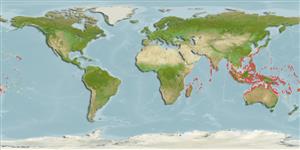Common names from other countries
>
Eupercaria/misc (Various families in series Eupercaria) >
Labridae (Wrasses)
Etymology: Labrichthys: Greek, labrax, -akos = a fish, Dicentrarchus labrax + Greek, ichtys = fish; it could be also understood with the menaing of "labros" = voracious (Ref. 45335).
More on author: Guichenot.
Environment: milieu / climate zone / depth range / distribution range
Ecologia
marino associati a barriera corallina; distribuzione batimetrica 0 - 20 m (Ref. 9710). Tropical; 20°N - 21°S
Indo-Pacific: East Africa to Micronesia and Samoa.
Size / Peso / Age
Maturity: Lm ? range ? - ? cm
Max length : 17.5 cm TL maschio/sesso non determinato; (Ref. 2334)
Spine dorsali (totale): 9; Raggi dorsali molli (totale): 11-12; Spine anali 3; Raggi anali molli: 10 - 11. Color in life: juveniles brown with 2 bluish white stripes on body, the lateral stripe disappearing with increase in size; female yellowish brown, stripes dull and faint; male color more intensified and bright than female color, a large yellow area beneath and above the pectoral fin base. Yellow lips thick and fleshy, forming a short tube when mouth is closed. Head entirely scaled except for sheath over base of upper lip, preorbital, and chin. Lacks teeth in the upper jaw between the two anterior pairs of canines and the large canine in each corner (Ref. 1602).
Inhabits shallow lagoon and semi-protected seaward reefs with high coral cover (Ref. 9710). Found near branching corals and feeds on its coral polyps, particularly staghorn Acropora (Ref. 9823).
Life cycle and mating behavior
Maturità | Riproduzione | Deposizione | Uova | Fecundity | Larve
Oviparous, with distinct pairing during breeding (Ref. 205).
Randall, J.E., G.R. Allen and R.C. Steene, 1990. Fishes of the Great Barrier Reef and Coral Sea. University of Hawaii Press, Honolulu, Hawaii. 506 p. (Ref. 2334)
IUCN Red List Status (Ref. 130435)
CITES (Ref. 128078)
Not Evaluated
Threat to humans
Harmless
Human uses
Pesca: scarso interesse commerciale; Acquario: Commerciale
Informazioni ulteriori
BibliografiaAcquacolturaProfilo di acquacolturaVarietàGeneticaElectrophoresesEreditarietàMalattieElaborazioneMass conversion
Strumenti
Special reports
Download XML
Fonti Internet
Estimates based on models
Preferred temperature (Ref.
115969): 26.6 - 29.3, mean 28.6 (based on 2330 cells).
Phylogenetic diversity index (Ref.
82804): PD
50 = 1.0000 [Uniqueness, from 0.5 = low to 2.0 = high].
Bayesian length-weight: a=0.00955 (0.00456 - 0.02002), b=3.06 (2.89 - 3.23), in cm Total Length, based on LWR estimates for this (Sub)family-body shape (Ref.
93245).
Trophic level (Ref.
69278): 3.3 ±0.6 se; based on diet studies.
Resilienza (Ref.
120179): Alto, tempo minimo di raddoppiamento della popolazione meno di 15 mesi (Preliminary K or Fecundity.).
Fishing Vulnerability (Ref.
59153): Low vulnerability (10 of 100).
